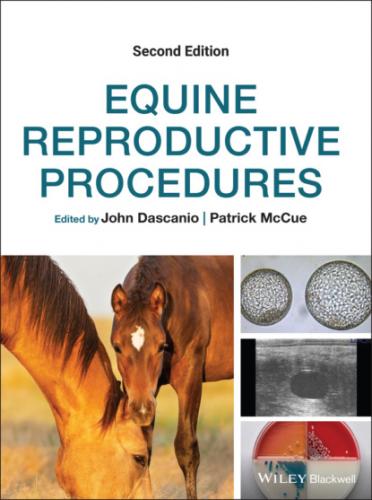Stem cell lines are developed elsewhere and usually sent for chromosome analysis as attached semiconfluent cultures in T75 flasks.
Upon arrival, all transport medium is removed and replaced with 10 ml regular cell culture medium (specified by the stem cell laboratory).
The cells are grown at 37°C in 5% CO2, inspected every day, and harvested when many mitotic cells are visible (Figure 22.1).
Cell harvest
Add ethidium bromide solution (100 μl per 10 ml culture; final concentration 10 μg/ml) and demecolcine solution (100 μl per 10 ml culture; final concentration 0.1 μg/ml) directly into cell culture tubes or flasks and incubate for 2 hours at 37°C.Figure 22.1 A semiconfluent horse fibroblast cell culture showing many dividing cells (round and bright; arrows); magnification 20×.
Blood cultures are grown in centrifuge tubes and can proceed directly to the next step. Cells in T25 or T75 cultures flasks need to be transferred into centrifuge tubes as follows: tap the flasks vigorously to detach loosely attached cells and transfer medium with loose cells into a centrifuge tube. Next, detach the remaining cells with trypsin as described above (see “Primary fibroblast cultures”) and transfer the cells into another centrifuge tube. Use more tubes if necessary.
Spin the cells at 100× g for 10 minutes and aspirate the supernatant leaving ~1 ml medium at the bottom. Re‐suspend the cell pellet gently with a plastic fine‐tip pipette.
Add 2–3 ml pre‐warmed (37°C) hypotonic solution, gently mix the cells with a pipette, and take the volume to 10 ml. Incubate for 20–30 minutes at 37°C.
Add 500 μl of cold fixative directly into the hypotonic solution and spin the cells down at 100× g for 10 minutes.
Aspirate the supernatant and gently re‐suspend the cells so that no clumps remain; add ~1 ml fresh fixative and mix the cells again; take the fixative volume to 5 ml, spin the cells at 100× g for 10 minutes, aspirate the supernatant, and repeat the fixation step three more times.
Aspirate most of the supernatant, leaving cells in ~200 μl fixative. Re‐suspend the cells by gentle pipetting and transfer the fixed cell suspension from 15 ml centrifuge tubes into 1.5–2.0 ml microcentrifuge tubes. Store the cell suspensions at –20°C (–4°F) until needed.
Chromosome preparations
Glass slides for chromosome preparations must be precleaned by soaking overnight in glass cleaning solution (chromic‐sulphuric acid) followed by overnight rinsing under running tap water. Clean slides are stored in distilled H2O at 4°C (39°F) until needed. A slide is clean when a water film spreads evenly over the glass surface.
To make chromosome preparations, drop approximately 10 μl of fixed cell suspension on one end of a wet slide and allow it to spread on the slide. Let the slide air‐dry and check it under a light microscope using 20× phase contrast objective for the number and quality of metaphase spreads. If the number of spreads is low, the cell suspension should be concentrated by centrifugation. If the metaphases are surrounded by cytoplasm and chromosomes are not spread, wash the cells with fixative for 2–3 more times. Slides can be stored in air‐tight boxes containing desiccant at –20°C for several years.
Giemsa staining
The method is used for basic chromosome analysis and is usually sufficient for counting the chromosome number and arranging horse chromosomes roughly into a karyotype.
Stain the slides in 4% Giemsa solution in Gurr buffer for 5 minutes.
Rinse the stain gently off with distilled water and air‐dry.
G‐banding
The method produces distinct banding patterns characteristic to individual horse chromosomes (Figures 22.2 and 22.3) and is used for refined chromosome analysis. It allows chromosome identification, arranging them into a karyotype following the international nomenclature (Bowling et al. 1997), and detecting numeric and structural abnormalities. There are many modifications to the original G‐banding method (Seabright 1971). The following procedure is used for G‐banding at the Molecular Cytogenetics Laboratory at Texas A&M University.
Figure 22.2 A G‐banded metaphase spread of a normal male horse; magnification 1,000×.
Figure 22.3 G‐banded chromosomes of a normal male horse arranged into a karyotype.
Bake slides on a hot plate at 70°C (158°F) for 10–20 minutes and allow to cool.
Dip the slides in HBSS for 1 minute.
Treat the slides with 0.125% trypsin working solution in HBSS for 1–5 seconds.
Dip the slides in HBSS containing 2% FBS for 1 minute.
Dip the slides in Gurr buffer for 1 minute.
Stain the slides in 4% Giemsa in Gurr buffer for 5 minutes and air‐dry.
Check the quality of chromosomes and G‐banding under a microscope and adjust the time of trypsin treatment and Giemsa staining if necessary.
C‐banding
This method specifically highlights centromeric regions of all chromosomes and produces distinct staining pattern on horse sex chromosomes (Figure 22.4). C‐banding is used to further verify the number and morphology of sex chromosomes. The method was originally developed by Arrighi and Hsu (1971) and includes the following steps:
Treat the slides with 0.1 N HCl at room temperature for 3 minutes and rinse in distilled water.
Treat the slides in 5% Ba(OH)2 at 60°C (140°F) for 3 minutes and rinse in distilled water.Figure 22.4 A C‐banded metaphase spread of a male horse; distinct C‐bands of the X and the Y chromosomes are highlighted at the lower right.
Treat the slides for 5 minutes in 2× SSC at 60°C and rinse in distilled water.
Stain the slides in 4% Giemsa in Gurr buffer for 1 hour, rinse gently in distilled water, and air‐dry.
Note: timings of treatment steps for C‐banding can vary between slides and individuals and may need adjustment.
Microscopy and image analysis
Normally, images of at least 30 metaphase spreads are captured and analyzed for each case and five representative cells are karyotyped.
Other Procedures
Polymerase
